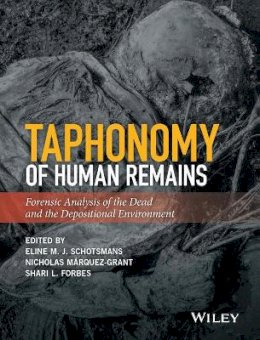
Stock image for illustration purposes only - book cover, edition or condition may vary.
Taphonomy of Human Remains: Forensic Analysis of the Dead and the Depositional Environment
Eline M. J. Schotsmans (Ed.)
€ 116.92
FREE Delivery in Ireland
Description for Taphonomy of Human Remains: Forensic Analysis of the Dead and the Depositional Environment
Hardcover. Num Pages: 544 pages. BIC Classification: JHBK; JKVF1; PS; RBX. Category: (P) Professional & Vocational. Dimension: 246 x 189. .
A truly interdisciplinary approach to this core subject within Forensic Science
- Combines essential theory with practical crime scene work
- Includes case studies
- Applicable to all time periods so has relevance for conventional archaeology, prehistory and anthropology
- Combines points of view from both established practitioners and young researchers to ensure relevance
Product Details
Format
Hardback
Publication date
2017
Publisher
John Wiley and Sons Ltd
Condition
New
Number of Pages
544
Place of Publication
Hoboken, United Kingdom
ISBN
9781118953327
SKU
V9781118953327
Shipping Time
Usually ships in 4 to 8 working days
Ref
99-2
About Eline M. J. Schotsmans (Ed.)
Eline M. J. Schotsmans is a post-doctoral researcher in forensic archaeology and taphonomy at the Laboratory of Anthropology of Past and Present Populations (PACEA) at the University of Bordeaux, France, and an honorary fellow at the University of Bradford, UK. She has worked on various forensic cases and conducts research in taphonomy that lies at the interface between archaeo-anthropology and forensic sciences. Nicholas Márquez-Grant is a Lecturer in Forensic Anthropology and Course Director MSc in Forensic Archaeology and Anthropology at Cranfield University, UK. He is also a Research Associate at the University of Oxford. He has analysed human remains from a number of countries and chronological periods and currently undertakes forensic casework in the UK. Shari Forbes is a Professor and ARC Future Fellow in the Centre for Forensic Science at the University of Technology Sydney. She is also the Director of the Australian Facility for Taphonomic Experimental Research (AFTER), the first facility in Australia that allows scientists to study the decomposition of human cadavers. She is regularly consulted on forensic casework and assists police to search for and locate human remains using police dogs and geophysical equipment.
Reviews for Taphonomy of Human Remains: Forensic Analysis of the Dead and the Depositional Environment
